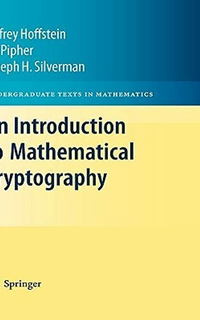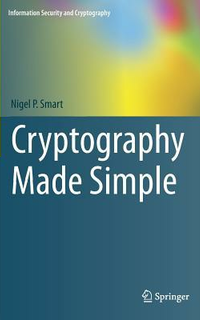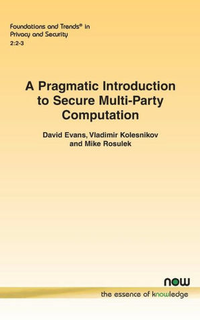Collection
Some Cryptography Books I Like
This is just a brief post going over a few books on Cryptography I’ve read, and would potentially recommend to people interested in the topic.
In fact, I’ve yet to encounter a book on Cryptography that I haven’t found something likeable or useful in, so this is mainly just a list of books I’ve read. I’ve had a few people ask me for some pointers to get into Cryptography, so hopefully this post can help those people out a bit. Personally, I find learning through books very effective, because it’s easy to go at your own pace, and books are often very effective at distilling a broad field into a very dense presentation. And that’s why my recommendations are mainly centered on books, although I’m sure there are other great resources, like videos or courses, outside of just books.
- Curated in Some Cryptography Books I Like
This is a really entertaining and accessible introduction to Cryptography. Unlike the other books in this section, this one doesn’t really assume any kind of mathematical background. In fact, this book is written with more of a programmer’s perspective in mind. For example, you see concrete examples of which APIs to use to generate random numbers in Linux as compared to Windows, which is a level of concrete detail you don’t really see in other books on Cryptography.
The book manages to cover quite a bit of material. I’d say there’s a larger focus on symmetric Cryptography, with a lot of more in-depth material on ciphers, hash functions, and things like that. There’s a lot of detail on different block cipher modes, and on the construction of different hash functions, among other things.
There are also some great overview chapters on public key Cryptography, including RSA and Elliptic Curves, but these don’t go as deep as the other books in this section.
I’d recommend this book to anyone trying to get a taste of Cryptography, and especially programmers trying to get their background knowledge up to speed.
- Curated in Some Cryptography Books I Like
This book is essentially an undergraduate course in Cryptography, like you’d see during a single semester of a CS degree.
As a disclaimer, I don’t think this book should really be read cover-to-cover, as there’s a lot of material which is very superfluous, in my view. For example, you can skip the first 7 chapters, which covers historical ciphers, unless you find that kind of thing interesting.
Nonetheless, this book does provide a useful introduction to many topics in public key Cryptography. It’s nice to see an overview of Zero-Knowledge proofs, for example. The presentation is more formal than the previous book, and is suitable for people who have a bit more background in math, or at least in some kind of formal reasoning. This book also provides a good amount of exercises, which can be very useful for learning.
- Curated in Some Cryptography Books I Like
This book is a very cohesive introduction to public key Cryptography. Like the previous book, this is a somewhat formal presentation, similar to what you’d find in an undergraduate course. This book also has a greater focus on the mathematics, as the title suggests. I don’t think the background required is greater, but it does require being a bit more comfortable with mathematical reasoning than the other books in this section.
This book goes over the foundational assumptions underpinning public key Cryptography, from RSA, to discrete logarithms, to elliptic curves, and even a small chapter on lattices. What’s nice about this book is that it provides a good overview of the various attacks on these systems. For example, different methods for factoring,or for computing the discrete logarithm. I still sometimes use this book as a reference, when I forget the details of Pohlig-Hellman, or something like that.
I’d strongly recommend this book to anyone wanting to get more seriously into Cryptography, although it might get somewhat boring for some people given its particular focus.

- Curated in Some Cryptography Books I Like
This is a really well presented book, and probably has some of the clearest explanations of game-based security in this entire list. I think a lot of that clarity is owed to the use of state separable proofs, which would honestly make many areas of Cryptography a lot clearer if people used them more. I’d recommend this book even to more accomplished Cryptographers, just as a good introduction to the proof technique.
In terms of the content, this book goes over a lot of topics in symmetric Cryptography, along with a handful of topics in public key Cryptography, with the focus being on proving the security of schemes.
This focus on proofs makes the content on symmetric Cryptography markedly different from the other books I’ve mentioned so far. The focus is more so on proving that you can build large secure constructions, like authenticated encryption, from small assumptions, like pseudo-random functions.
One downside of this book is that there’s not a lot of material on public key Cryptography. I wish there were more material here, because there would be tons of interesting things to cover, even if only focusing on the provable security aspect of composing constructions.
I’d highly recommend this book to anyone who hasn’t read it, especially people who know about Cryptography, but haven’t heard much about state separable proofs yet.

- Curated in Some Cryptography Books I Like
This book is similar in scope to the previous one, with less focus on provable security. There is still some presentation of more traditional game-based security, but this is slowly introduced, rather than being used pervasively.
Unlike the previous book, there’s also a better coverage of public key Cryptography. Many of the same topics as in “An Introduction to Mathematical Cryptography” are covered, but with more focus on algorithms rather than the mathematics.
The book also has some very nice presentation on more advanced topics, like Zero-Knowledge proofs and secure multi-party computation, as well as concrete examples, such as TLS certificates.
This book might even be a good introduction, but I think the material is hard enough to make this more suitable as a second book.

- Curated in Some Cryptography Books I Like
This book provides a very thorough presentation of symmetric and public key Cryptography, with a very present focus on provable security, and in particular, game-based security. This is a challenging, but also rewarding introduction to a very rigorous kind of Cryptography. The book also features plenty of exercises, which present a pretty wide range of situations, and really help to flesh out all of the nooks and crannies of the material.
The main downside of this book is that it’s not finished yet. This is a pretty big problem, actually, because one consequence is that there are no references to the existing literature, which is quite annoying. This book would easily be 10 times more useful if it had those references, because it would act as an even greater stepping stone to get into the literature on Cryptography. Some of the advertised future sections on Cryptographic protocols would be great as well, since that’s an area that doesn’t have as much focus throughout the rest of these books.
Nonetheless, I think this book is such a good and challenging read that I have to recommend it to everyone who wants to dive deep into Cryptography, but I hope it does get finished sometime soon.

- Curated in Some Cryptography Books I Like
If you want to implement elliptic curves, this book is a must read. It’s essentially a comprehensive guide on all of the arithmetic needed to implement curves, from finite fields, to various approaches to adding points, to scalar multiplication, etc.
A lot of less popular kinds of elliptic curves are also prominently feature in this book, such as optimal curves over optimal extension fields. This probably reflects the point in time where this book was written, where we hadn’t yet settled on a few curves over prime fields.
I still use this book as a reference quite a bit. Most recently, I needed to implement a binary field, and I referenced the algorithms in this book heavily.
One downside of this book is its age, so it doesn’t feature some of the newer constant time ladders for scalar multiplication, among other things. There’s been some interesting work here in recent years, like “Complete addition formulas for prime order elliptic curves”. Obviously, this book couldn’t have referenced a paper written 10 years in the future, but an updated version of this book might be interesting to incorporate these aspects. Some material on pairings would be nice in an updated version as well.
If you want to implement elliptic curves from scratch, this book is a valuable reference.

- Curated in Some Cryptography Books I Like
This is a very complete reference book on Elliptic Curve Cryptography. I say reference book because this really shouldn’t be read cover-to-cover, or at least, I wouldn’t recommend doing that. This goes a lot more in-depth than the previous book, with a much heavier focus on mathematics.
Each of the chapters in the book is more or less independent, although they do build on each other, with some of the earlier chapters providing some more foundational material. The chapters are almost like individual papers. In fact, on a few occasions, I’ve stumbled upon papers when researching a topic, only to realize that they were actually chapters from this book.
For example, I had read the chapter on Montgomery Ladders before realizing that it was actually an excerpt from this book. I had read the paper multiple times too, while implementing Curve25519, but it had never clicked.
This is a book you want to have on your shelf if you’re interested in Elliptic Curve Cryptography.

- Curated in Some Cryptography Books I Like
I have read this book, on the other hand. In fact, I read this book quite a few years ago before I was seriously interested in Cryptography.
This book provides an interesting view on the concrete applications of Cryptography, with a focus on what I’ll call more “traditional” Cryptography. So, a lot of symmetric Cryptography, with a focus on various block cipher modes, and usages of hash functions, along with some basic uses of public key Cryptography, for encryption and signatures.
With a bit of hindsight, I think this book is great, but perhaps a bit outdated. This book doesn’t really contain any mistakes, but I think the presentation of certain topics would be different if the book were written now. For example, I would like to see encryption focus more on AEAD modes, over block cipher modes. For public key Cryptography, I think presentations on Elliptic Curve Cryptography would be important, if not even Post-Quantum Cryptography. There’s also more advanced applications of public key Cryptography than just encryption and signatures, so I feel like presenting those would be interesting as well.
Nonetheless, there’s a lot of interesting material in this book which can’t be found elsewhere, like the chapter on storing key material. The presentation of the book is also really great, with a consistently approachable and grounded writing style.
So, there’s a lot of things to take away from this book, but I wouldn’t vehemently recommend it. On the other hand, it is sort of a “classic” at this point, so it should probably feature somewhere on your bookshelf.

- Curated in Some Cryptography Books I Like
I read this one quite recently, and I’d highly recommend it. This book is an overview of different MPC techniques, from a very high-level. The book starts with a brief introduction to simulation-based security, which is how we usually reason about security when working with Cryptographic protocols, and then jumps to describing various MPC protocols in various threat models.
The book doesn’t provide a very deep explanation of the protocols, but it does provide enough to give you a high level overview of the techniques involved, and how they compare with each-other. A great thing about this book is that it’s very well referenced, so it’s easy to use it as a stepping stone to dive into the literature and learn more.
I highly recommend this book if you’re interested in MPC. It’s also a short read, so if you’re not interested in MPC, you should still give it a look, and you might change that.

